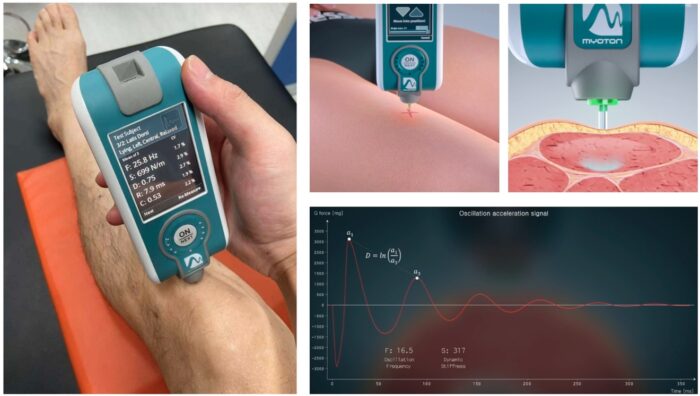Publications

Associations of Lower Limb Muscle-Tendon Properties with Dual-Task Gait Variability: A Cross-Age Study
Authors: Zheng Dong 1, YoungJin Moon 1, Sang Ki Lee 1, Hwi-yeol Yun 2, JuWon Song 1, JiaHao Xu 1, Min Ju Shin 1, DuBin Im 1, XuanRu Wang 1
Affiliations:
- Department of Sport Science, Chungnam National University, Daejeon 34134, Republic of Korea
- College of Pharmacy, Chungnam National University, Daejeon 34134, Republic of Korea
Journal: Healthcare - June 2025, Volume 13, Issue 12, Article no. 1375 (DOI: 10.3390/healthcare13121375)
-
Field & Applications:
- Medical
- Gerontology / Ageing
- Musculoskeletal health
- Balance / Postural control
- Injury prevention
- The findings of this study suggest that non-invasive, handheld myotonometers such as the MyotonPRO hold significant promise for clinical application in geriatric care. With advantages including ease of use, rapid measurement, and high repeatability, these devices are particularly suitable for screening and assessment in frail older adults. Their portability facilitates integration into primary care settings, community-based fall prevention programs, and bedside evaluations in long-term care facilities, as part of comprehensive geriatric assessments.
Objectives: This study is the first to investigate the association between lower limb muscle-tendon mechanical properties and dual-task gait variability using a handheld, non-invasive myotonometer (MyotonPRO).
Methods: A cross-sectional design was employed, involving 48 participants (older adults: 72.05 ± 3.52 years; younger adults: 24.8 ± 2.36 years). The stiffness and elasticity of dominant lower limb muscles and tendons were assessed using the MyotonPRO. Gait variability – including step length, stride length, and gait cycle time – was measured using the OptoGait system.
Results: Compared to the younger group, older adults showed increased stiffness of the patellar tendon (p < 0.001) and decreased stiffness of the Achilles tendon (p < 0.047). Additionally, both the rectus femoris and biceps femoris exhibited significantly higher stiffness (p < 0.05) and reduced elasticity (p < 0.001). Patellar tendon stiffness was positively correlated with gait variability (r = 0.55 to 0.68, p < 0.01), whereas Achilles tendon stiffness showed a negative correlation (r = −0.32 to −0.40, p < 0.05).
Conclusions: This study provides preliminary evidence linking muscle-tendon mechanical properties with dual-task gait stability in older adults. Increased stiffness in the patellar tendon and decreased stiffness in the Achilles tendon suggest these structural characteristics may play a crucial role in gait control and hold potential as predictive markers of fall risk. Linking non-invasive MyotonPRO-derived mechanical properties with key spatiotemporal gait parameters may support its potential use in the early detection of gait instability in older adults.

Figure 1. The left panel shows the on-site measurement of the patellar tendon using the MyotonPRO device. The right images depict the official schematic representation of MyotonPRO’s measurement principle, demonstrating the application of mechanical impulses and tissue response.
Keywords: gait variability, muscle-tendon stiffness, MyotonPRO, aging, dual task
This study identified a significant association between the stiffness and elasticity of lower limb muscles and tendons – measured using a non-invasive handheld device – and gait variability. Compared to younger adults, older adults exhibited greater stiffness in the rectus femoris, biceps femoris, and patellar tendon, along with reduced stiffness in the Achilles tendon. These structural differences may reflect adaptive changes in gait patterns associated with aging. Under dual-task conditions, cognitive load appeared to further amplify the age-related modulation of these structure-function relationships. Specific mechanical properties may serve as indicators of gait changes in certain contexts, but their clinical utility requires further validation.


